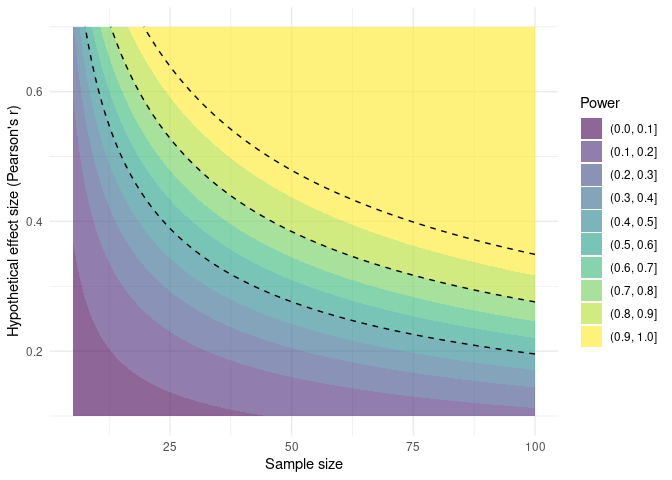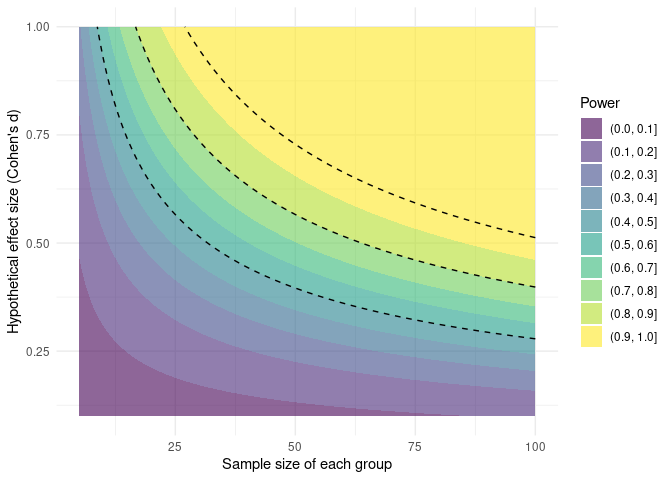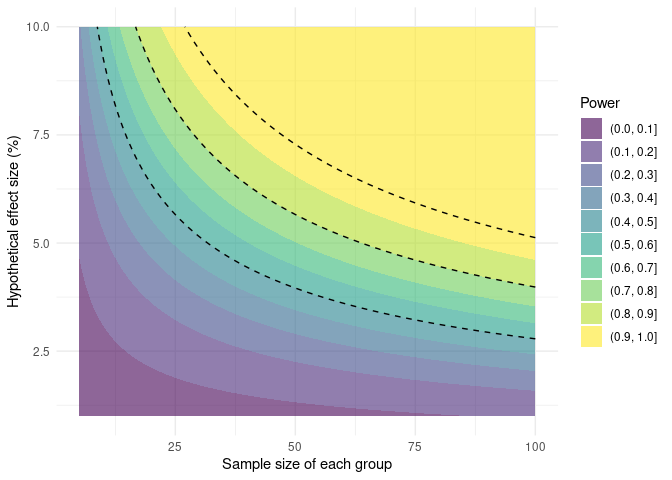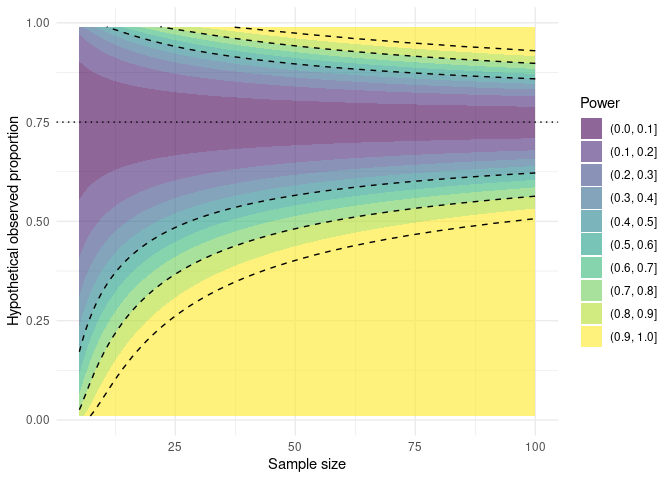pwrcontour
The goal of pwrcontour is to present power analyses in which it is possible to evaluate power for numerous hypothetical effect sizes at once. This makes it easier to communicate the fact that power is a calibration for different potential contingencies of the true size of the effect of interest. This is based on the tables and figures created by Richard Morey in the jamovi jpower module.
This package is still in alpha, and more features will likely be added at a later point.
Installation
You can install the released version of pwrcontour from Github with:
remotes::install_github("mathesong/pwrcontour")Example
The main functions are simply for plotting power contours, or examining
power tables, based around the syntax of the functions in the pwr
package.
Correlations
library(pwrcontour)
pwr.r.test.contour(nmin = 5, nmax = 100, rmin = 0.1, rmax = 0.7)pwr.r.test.table(n = 25)| True Effect Size (Pearson’s r) | Power to detect | Description |
|---|---|---|
| r < 0.389 | < 50% | Likely miss |
| 0.389 < r < 0.528 | 50% - 80% | Good chance of missing |
| 0.528 < r < 0.639 | 80% - 95% | Probably detect |
| r > 0.639 | > 95% | Almost surely detect |
Power by effect size
T-tests
pwr.t.test.contour(nmin = 5, nmax = 100, esmin = 0.1, esmax = 1)pwr.t.test.table(n = 25)| True Effect Size (Cohen’s d) | Power to detect | Description |
|---|---|---|
| delta < 0.566 | < 50% | Likely miss |
| 0.566 < delta < 0.809 | 50% - 80% | Good chance of missing |
| 0.809 < delta < 1.041 | 80% - 95% | Probably detect |
| delta > 1.041 | > 95% | Almost surely detect |
Power by effect size
This package also makes it possible to present these figures in the raw units of analysis. For example, if we know that a 10% change is equivalent to a Cohen’s d of 1, we can incorporate this into the figure.
pwr.t.test.contour(nmin = 5, nmax = 100, esmin = 1, esmax = 10,
d_unitconversion = 10, d_units = "%")pwr.t.test.table(25, d_unitconversion = 10, d_units = "%")| True Effect Size (%) | Power to detect | Description |
|---|---|---|
| delta < 5.656 | < 50% | Likely miss |
| 5.656 < delta < 8.087 | 50% - 80% | Good chance of missing |
| 8.087 < delta < 10.407 | 80% - 95% | Probably detect |
| delta > 10.407 | > 95% | Almost surely detect |
Power by effect size
Proportion tests
Then there’s also proportion tests. I decided to discard the Cohen’s h,
as this feels like it complicates things unnecessarily. So we set up a
proportion to compare to instead, called propcomp
pwr.prop.test.contour(nmin = 5, nmax = 100, propmin = 0.01, propmax = 0.99,
propcomp = 0.75)pwr.prop.test.table(n=75, propcomp=0.75)| True Increased Proportion | True Decreased Proportion | Power to detect | Description |
|---|---|---|---|
| prop < 0.874 | prop > 0.601 | < 50% | Likely miss |
| 0.874 < prop < 0.916 | 0.601 > prop > 0.533 | 50% - 80% | Good chance of missing |
| 0.916 < prop < 0.948 | 0.533 > prop > 0.467 | 80% - 95% | Probably detect |
| prop > 0.948 | prop < 0.467 | > 95% | Almost surely detect |
Power by proportion, relative to 0.75



